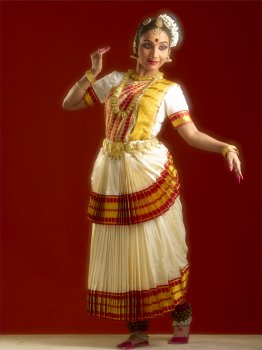
Homage to
Swathi Thirunal
- Padma Jayaraj,
Thrissur
e-mail: padmajayaraj@gmail.com
April 28,
2008
 Maharaja
Swathi Thirunal Rama Varma (1813 to 1846) patronized a cultural renaissance
in South India. The Maharaja still reigns the realm of musicians and artistes.
To pay tribute to his legacy the Government of Kerala confers Swathi
Puraskar to maestros who leave their signature on Indian music. This
year's recipient is Pandit Jasraj, an eminent Hindustani musician. And
a three-day music-dance festival from 18th April made the cultural capital
of Kerala festive. Maharaja
Swathi Thirunal Rama Varma (1813 to 1846) patronized a cultural renaissance
in South India. The Maharaja still reigns the realm of musicians and artistes.
To pay tribute to his legacy the Government of Kerala confers Swathi
Puraskar to maestros who leave their signature on Indian music. This
year's recipient is Pandit Jasraj, an eminent Hindustani musician. And
a three-day music-dance festival from 18th April made the cultural capital
of Kerala festive.
Neena Prasad,
a top ranking Mohiniattam artiste, gave a concert on the second evening.
For the occasion, Neena chose Swathi kritis for her recitals. Classical
in content and style, her performance was an eloquent expression of graceful
lasya highlighting the innate dignity of the feminine. Highly individualistic
in flavor, simplicity and lucidity marked her style of performance. It
was an interesting learning experience in the subtleties of Mohiniattam.
Confined to the established frame work, the dancer explored innovative
ways of presentations.
Traditional
in style, the performance began with Ganesh stuti. The opening numbers,
a Cholkattu in ragam reethi gaula and Chaturasra jati Ata thalam, pancha
natai was a remarkable piece of choreography that showed how rhythm can
be so effective. Thematically, the thrust was on devotion and lord Ganapathy
emerged as envisioned by the devotee. It set the mood of bhakti,
the stamp of Swathi kritis.
The second
item, a Swathi composition in hamsanandini ragam, adi talam was a kriti.
Here, lord Siva is in deep meditation and the Third Eye is powerful and
open. The power of the inner Eye is the burthen of the lyric. His consort,
Parvati is troubled to see its effect on Nature. The fiery Eye is melting
the very Himalayas, off-setting balance. It is not yet time for samhara.
Stiti has to be maintained. So she interferes to restore the benign aspect
of her lord. As Siva opens his eyes, the third Eye shuts itself. Harmony
reigns; calm flows life on Earth; Parvathi is happy, so is Nature. The
item show cases how a lasya dance can present a thandava theme. The choreography
transcends the limitation of Mohiniattam to present power and fury, speaks
of the innovative talent of Neena.
The third
piece in ragam Mukhari and Adi talam was a padavarnam. The dance recital
enshrines Swathi Thirunal's ishta devata, Sree Padmanabha. His devotion
to the presiding deity of the Travancore royal family has left its imprint
in the innumerable kritis the king penned. A mystic theme of the lovelorn
human psyche waiting bathed in religious aura is a beautiful rendition
of lasya bhava. Sringara touches its sublime peak as the sakhi takes the
Lord to his waiting consort-devotee. There is something truly regal about
the waiting lover unseen on the stage. The lyric speaks in volumes of the
Maharaja's devotion and inner longing.
The next piece
from Geeta Govindam was an ashtapathi. Radha waiting for Krishna on the
banks of the river Kalindi, is told to by the sakhi to go and seek Krishna.
"He will not
come looking for you," her Sakhi tells. Yes, even the sunflower turns
sunward. And the human needs to search for the divine.
"Go garbed
in blue, when the deep, blue night is still to seek the beautiful blue
god, Krishna."
The white
melting into the blue is beautiful indeed. Here again it is the sakhi who
speaks of Radha's travails. The erotic is sublimated with the sakhi giving
a sense of direction and spiritual dimension to the theme of love.
What is unique
in the rendition is the role of the sakhi. Sakhi takes the centre-stage,
not the virahotkandita nayika that has become a stereotype in our classical
dance numbers. Sakhi is the mediator, felicitator and the interpreter.
Two lyrics from two different composers are taken to juxtapose two approaches
that are complementary. Symbolically, the purusha goes to prakriti: the
feminine seeks the masculine. The mystic theme of divine coming to
the human and the human seeking the divine makes the performance wholesome.
Even at the gross physical level of love, man-woman relationship is cast
on an equal plane.
The last item
was a thillana a popular Swathi composition. Incorporating the rhythmic
variety of Carnatic tala system in ragamalika and thalamalika, the fast
number was a fitting grand finale for the subdued aesthetics of a hauntingly
slow Mohiniattam concert.
Ably supported
by an orchestral team, the dance and the music jelled in wonderful harmony:
Vocal - Changanasseri Madhavan Namputhiri, violin-VK Haridas, veena-Trichur
Murali, Edakka-Krishna Kumar, Mrudangam - Vaipin Satish, and Nattuvangam
-Kottayam Unnikrishnan
Neena Prasad
has graced distinguished stages, both at home and abroad and is one of
the prominent artistes of the younger generation of Mohiniattam dancers.
Noted for focused expression, chiseled movements, a wonderful sense of
rhythm and innovative choreography, her performance is aesthetically captivating,
filling the audience with a serenity non parallel. Her mind caught in the
traumas of our times is eager for experiments. Mohiniattam which badly
needs innovative choreographers is sure to go a long way with Neena Prasad,
the researcher and the institution builder who takes her disciples on board
to uncharted seas.
"This legacy
of Mohiniattam should be taken to many people around the world. In my own
little way, if I can achieve that, then that is what I will cherish..."
Dr. Neena Prasad looks into future.
Padma
Jayaraj is a regular contributor to www.narthaki.com |

